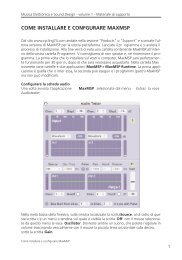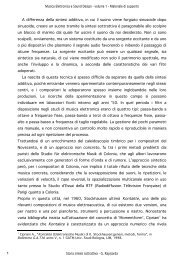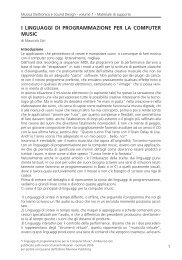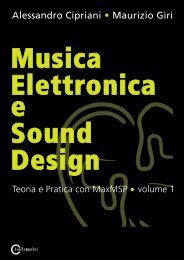programming with max/msp - Virtual Sound
programming with max/msp - Virtual Sound
programming with max/msp - Virtual Sound
You also want an ePaper? Increase the reach of your titles
YUMPU automatically turns print PDFs into web optimized ePapers that Google loves.
LEARNING AGENDA 1P<br />
PREREQUISITES FOR THE CHAPTER<br />
• Basic computer knowledge<br />
(operating a computer, managing files and folders audio formats, etc.)<br />
• Basic knowledge of music theory (semitones, octaves, rhythm, etc.)<br />
• contents of the theory part of chapter 1<br />
(it is Best to study one chapter at a time, starting <strong>with</strong> the theory and then<br />
progressing to the corresponding chapter on practical <strong>max</strong>/<strong>msp</strong> techniques.)<br />
LEARNING OBJECTIVES<br />
SkillS<br />
• to Be aBle to use all of the Basic functions of <strong>max</strong>/<strong>msp</strong><br />
• to Be aBle to synthesize Both sequenced and overlapping sounds using sine wave<br />
oscillators, as well as square wave, triangle wave, and sawtooth wave oscillators<br />
• to Be aBle to continuously control the amplitude, frequency, and stereo<br />
spatialization of a sound (using linear and exponential envelopes for glissandi,<br />
amplitude envelopes, and the placement of sound in a stereo image)<br />
• to Be aBle to generate random sequences of synthesized sound<br />
• to Be aBle to work <strong>with</strong> and manage elements of sampled sound<br />
CompetenCe<br />
• to successfully realize a first sound study Based on the techniques you have<br />
acquired in this chapter, and save your work as an audio file<br />
CONTENTS<br />
• sound synthesis and signal processing<br />
• the timBre, pitch and intensity of sound<br />
• glissandi and amplitude envelopes<br />
• relationships Between frequency, pitch, and midi<br />
• introduction to working <strong>with</strong> sampled sound<br />
• introduction to panning<br />
• some Basics of the <strong>max</strong>/<strong>msp</strong> environment<br />
ACTIVITIES<br />
• suBstituting parts of algorithms<br />
• correcting algorithms<br />
• completing algorithms<br />
• analyzing algorithms<br />
• constructing new algorithms<br />
TESTING<br />
• integrated cross-functional project: reverse engineering<br />
SUPPORTING MATERIALS<br />
• list of principal <strong>max</strong>/<strong>msp</strong> commands<br />
• list of <strong>max</strong>/<strong>msp</strong> oBjects used in this chapter<br />
• commands, attriButes, and parameters for some <strong>max</strong>/<strong>msp</strong> oBjects used in this<br />
chapter<br />
• glossary of terms used in this chapter<br />
from “Electronic Music and <strong>Sound</strong> Design” Vol. 1 by Alessandro Cipriani and Maurizio Giri<br />
© ConTempoNet 2010 - All rights reserved







